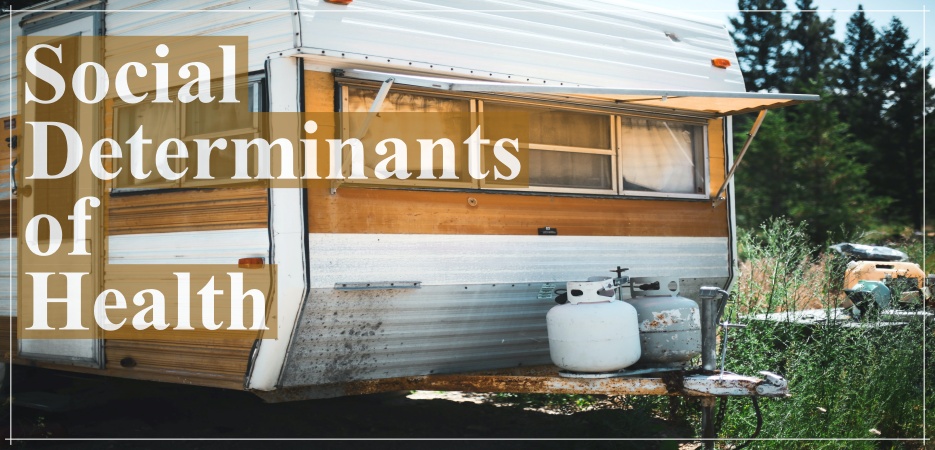“Clinical care [the application of medical and behavioral health] currently accounts for only 20 percent of health outcomes,” the issue brief noted. “To improve care and population health outcomes, healthcare providers must address other factors, including social determinants of health. To do this, we must first focus on addressing the variability in capturing and documenting social determinants in order to use this health data to benefit patients.” (1)
The above quote is very sobering and scary. It means that even in the face of the best possible clinical care of doctors, nurses, Nurse Practitioners, surgery, CT scans, hospitals, etc., etc. there’s an 80% chance of any patient returning to a hospital, becoming ill again, developing a more severe health condition, and so on. It also means that one cannot divorce patients/clients from the rest of their world once they leave the walls of the hospital or doctors’ office. The real world – their world of family, bills, medications, supportive home environment or the lack of it, becomes real again. The social determinants of health (SDOH) is the real world, and it dominates the existence of all people.
What are the Social Determinants of Health?
The social determinants of health are any and all components that contribute to the health and wellbeing of a person other than direct medical or behavioral care. Of course, this description allows for nearly anything to be considered in one’s life. However, there are categories that are specific to this issue. Housing, finances, geographical location, social services, and education are all considered to be major determinants. Additionally, there are also the micro SDOH. In this article we will intermix components of both for discussion.
As it is in life in general, those with less financial capability are more at risk of the SDOH being of greater importance because the margin for unresolved problems to occur is so much smaller. Nevertheless, SDOH can affect anyone depending on what may be central to their immediate wellbeing. Here is a list of what’s called the micro SDOH: (9)
- Medical Care Management: fully integrated management of disease
- Autonomy: independently care for ones-self
- Self-reliance: mobility, hygiene, eating, etc.
- Safety: eliminating thoseissues that can increase harm
- Economics: one’s financial capability to access care, which includes transportation, medication, etc.
- Burden of Care: anycaregivers and/or family members that provide supportive services and
- Quality of Life: being happy and having dignity in one’s life and lifestyle.
In this case, “micro” does not mean less important but more focused or a more defined category. Each of these carries its own level of significance in one’s life. The closer one gets to the poverty line, however, the greater weight each of these criteria has. It begins to get to the point where medical care management may be last, or non-existent, since the person may not even be able to get care. Such is the case with many seniors, veterans, the underserved, children, the mentally ill, drug addicts, immigrants, etc. This, no doubt, becomes an issue of housing first and foremost as a major inflection point.
Hospitals particularly, and healthcare in general, have attempted to address SDOH but the efforts must be a cohesive, coordinated one with primary care providers, the family, social workers, home health care and the like. This seamless cooperation is rarely found. Nevertheless, SDOH have been on the radar screen for many years and has not gone away. It remains a focal point for all stakeholders. The issue is how to maximize it for any patient or population.
Geography
Geography, one of the major categories, plays a singular, critical role with so many patients as it is a key determinant of patients’ access to care if that care is remote and/or lacks good public transportation. This is a dominant factor primarily for the underserved and native populations. Even if there is public transportation, can they afford the fare? Or is access to transportation affected by the elements? Consider communities in the north during winter: NY, Chicago, etc. How many people are directly affected, even for a few months, when there’s severe weather and they can’t get to the doctors’ office or get their medications?
In this case, and others where geography is a factor, telemedicine is a welcome addition to services offered from a provider. This also benefits pediatric and senior populations, as well as for those needing behavioral health services. With this, IT applications have become very important in the care equation, such as with electronic medical records and remote patient monitoring (RPM). (8)
Deaths Attributed to SDOH
One study quantified the number of deaths attributed to SDOH. “Galea et al quantified the number of deaths attributable to social factors. They estimated that in the year 2000, approximately 423,000 deaths in the US were attributable to poverty, 245,000 were attributable to low educational status, 162,000 to low socioeconomic support, and 119,000 to income inequality. (2, 5) To a large extent, social and economic stressors also drive the so-called “diseases of despair”: Suicide, alcohol abuse, and opioid addiction. These diseases are creating pain and suffering for millions of American families and leading to declines in life expectancy for certain segments of the population.” (3, 5)
In case of the latter, “diseases of despair,” are particularly significant for African Americans because they have never experienced periods when there was no despair caused by racial discrimination and implicit bias. (4) And interestingly, neither racial discrimination nor implicit bias are considered part of the SDOH.
That said, “The US is at the bottom of the pack of industrialized nations in terms of most measures of population health, but we are at the top in terms of how much we spend on health care relative to social services.” (5)
New Applications in Health Care and the SDOH
Given the above information, and also considering the recent COVID-19 pandemic, is there anything we’ve learned to advance healthcare and the SDOH? The answer is: yes. However – and unfortunately – it comes at the expense of so many lives lost during the pandemic. What we saw during this period in the US was the exposure of the American healthcare model’s lack of attention to its most vulnerable populations: seniors, the chronically ill and underserved populations.
COVID-19 struck the Black, Latino, and Native Americans the hardest at twice the death rate of white populations. These populations had/have the highest levels of chronic diseases and the greatest amounts of socioeconomic discrimination, and poor access to healthcare. (6)
Regarding senior populations, COVID-19 has been devasting on many fronts. Not just from the disease directly, but also from its necessary consequences of isolation, causing loneliness, depression, limited access to food, social service, family, and ~80% of all COVID related deaths occurring in those 65 +. (7)
What we learned was that for many populations, especially seniors and the chronically ill, one does not need to go to a brick-and-mortar office to receive healthcare. In fact, during the pandemic people were told, “do not go to the doctor’s office or to the hospital.” That is, unless you were dying from COVID. The underserved populations also realized that they too could be better served using digital health.
The applications of digital health – telemedicine (remote care delivered by doctors, Nurse Practitioners or Physician Assistants), or telehealth, (remote care delivered by RNs, pharmacist, Physical Therapist, etc.), and RPM – were all appropriate methods of care whose use immediately accelerated and rapidly “modernized” healthcare access across the board. As such, SDOH were also realized they could be increased to support the isolated and be delivered in similar fashion. Thus, it increased the integration and utilization of medical, behavioral and SDOH together. Furthermore, it went well beyond the usual SDOH to include video visits by families, food delivery, entertainment, and everything else needed by people who could not be engaged by direct contact with each other. (8)
Conclusion
SDOH are upside down in the US when considering the costs spent on delivering healthcare services versus understanding how and why SDOH affect the cause and effects of diseases and health. Out of necessity, due to the COVID pandemic, perhaps we’ve learned that all populations benefit greatly, especially the most vulnerable, when SDOH are considered first, and integrated with traditional healthcare applications using digital technology to help mitigate the lack of healthcare equity.
Citations:
- Health IT Analytics. Social, Behavioral Data Must Be Included in EHRs, Nurses Say. Jennifer Bresnick. Sept. 14, 2015. https://healthitanalytics.com/news/social-behavioral-data-must-be-included-in-ehrs-nurses-say.
- Galea S, Tracy M, Hoggatt KJ, Dimaggio C, Karpati A. Estimated deaths attributable to social factors in the United States. Am J Public Health. 2011 Aug;101(8):1456–65.
- Case A, Deaton A. Rising morbidity and mortality in midlife among white non-Hispanic Americans in the 21st century. Proc Natl Acad Sci U S A. 2015 Dec 8;112(49):15078–83.
- Walker, R. W. Black Health Matters; Square One Publishers, 2021, TBD.
- Perm J. 2018; 22: 18-139. Published online 2018 Oct 22. Health Care Steps Up to Social Determinants of Health: Current Context. Loel S Solomon, PhD, MPP. Michael H Kanter, MD
- The COVID-19 Pandemic Has Hit People of Color the Hardest, Including Among People with Medicare. https://www.kff.org/medicare/press-release/the-covid-19-pandemic-has-hit-people-of-color-the-hardest-including-among-people-with-medicare/Published: Feb 16, 2021
- CDC. COVID-19 Provisional Counts – Weekly Updates by Select Demographic and Geographic Characteristics. National Center for Health Statistics (2020). Available online at: https://www.cdc.gov/nchs/nvss/vsrr/covid_weekly/index.htm (accessed October 4, 2020).
- PERSPECTIVE. Front. Psychiatry, 12 November 2020 | https://doi.org/10.3389/fpsyt.2020.577427 The Effects of COVID-19 Among the Elderly Population: A Case for Closing the Digital Divide. Gabrielle Martins Van Jaarsveld
- Hughes, N. MD and Bartosh, R. Reducing Hospitalization Rates for at-risk Senior Populations using a Micro Social Determinants of Health Model. Publication TBD.














